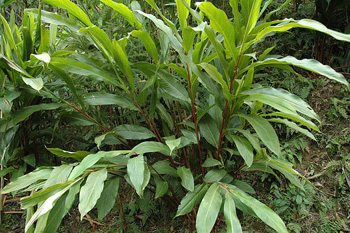Cardamom
(Elettaria cardamomum)
Cardamom is a well known and loved spice from the Indian subcontinent, often used as an ingredient in chai tea and used to flavor curries, desserts, and liqueurs. In Egypt and the Middle East, cardamom is ground and put into coffee to offset the acidic effects of coffee in the body (and it adds a delicious flavor)!
Family: Zingiberaceae (Ginger family)
Parts Used: dried ripe seeds
Energetics: pungent, aromatic, warming, drying
Actions: digestive stimulant, expectorant, carminative, diaphoretic
Uses: Excerpted from The Yoga of Herbs by Dr. Frawley & Dr. Lad:
“Cardamom is one of the best & safest digestive stimulants. It awakens the spleen, stimulates samana vayu (similar to the solar plexus), enkindles Agni (the digestive fire) and removes Kapha (excess water & mucus) from the stomach & lungs. It stimulates the mind and heart and gives clarity and joy. Added to milk it neutralizes its mucus forming properties and it detoxifies cafein in coffee. Its quality is sattvic and its particularly good for opening and soothing the flow of the pranas in the body.” (p.109)
Indications: nervous digestive upset in children, belching, flatulence, indigestion (especially when dairy leads to digestive upset), excessive mucus production, wet/boggy coughs
Description: excerpted from A Modern Herbal by Maude Grieve:
“The large perennial herb. yielding Cardamom seeds is known in its own country as ‘Elattari’ or ‘Ilachi,’ while ‘Cardamomum’ was the name by which some Indian spice was known in classical times.It has a large, fleshy rhizome, and the alternate, lanceolate leaves are blades from 1 to 2 1/2 feet long, smooth and dark green above, pale, glaucous green and finely silky beneath. The flowering stems spread horizontally near the ground, from a few inches to 2 feet long, and bear small, loose racemes, the small flowers being usually yellowish, with a violet lip. The fruits are from 2/5 to 4/5 of an inch long, ovoid or oblong, bluntly triangular in section, shortly beaked at the apex, pale yellowish grey in colour, plump, and nearly smooth. They are three-celled, and contain in each cell two rows of small seeds of a dark, reddish-brown colour.” (p.159)
Contraindications: large amounts of cardamom can aggravate ulcers or other excess Pitta conditions.
Recipe: Baked Pears with Cardamom

Ingredients:
1/2 tsp cardamom
2 whole pears
1/2 cup water
Preparation:
1. Preheat the oven to 350.
2. Lay pears down on a baking dish.
3. Coat the bottom of the dish with water.
4. Sprinkle the pears with cardamom.
5. Bake at 350 til tender.
Check out this website for many wonderful Ayurvedic recipes! You can type cardamom into the search field to see a full list of recipes using this incredible spice.
**This information is for educational purposes only and is not intended to diagnose or treat any disease**



